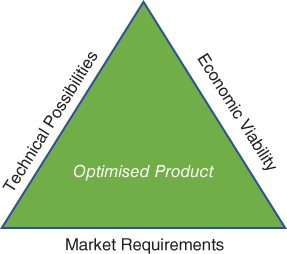6Developing the Concept
6.1 Introduction
Reference was made in Chapter 2 to the tension between two fundamental aspects of the engineering process:
- The fact that it is essentially a creative activity, developing new ideas to solve problems and to improve people's well‐being. As such, it is also the source of the innovation that drives business and economic growth in an industrial context.
- On the other hand, there is an element of conservatism in that those new engineering solutions must be reliable, robust, and not create harm, danger, or adverse environmental impact. In this respect, the world is becoming increasingly critical and risks or problems must be identified and fully overcome before a new technology or product is launched.
This chapter is concerned with the first of these points – the development of new concepts. This stage of work brings together three parameters: future market needs, possibilities in terms of new technology and engineering, and economic viability. A constant balance has to be struck between these competing requirements, as illustrated in Figure 6.1.

Figure 6.1 Balancing market, technical, and economic needs.
As an essentially creative process, it is not one which can be readily codified or proceduralised. However, the concept of good practice does apply and business school research (Ref. 1) into this front‐end process has given some useful guidance, ...
Get Managing Technology and Product Development Programmes now with the O’Reilly learning platform.
O’Reilly members experience books, live events, courses curated by job role, and more from O’Reilly and nearly 200 top publishers.

